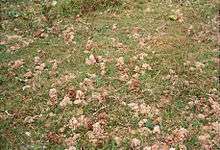Megascolecidae
The Megascolecidae are a large family of earthworms which has native representatives in Australia, New Zealand, both Southeast and East Asia, and North America. The most ancient lineages of the family show a Gondwanan distribution and have been used as evidence of continental drift. Members of the Pheretima group of genera (e.g. Amynthas) are widely distributed around the tropics, much as some Lumbricidae are distributed through the temperate zones. Some North American native genera – e.g., Arctiostrotus, Argilophilus and Driloleirus – also belong to this family.
| Megascolecidae | |
|---|---|
 | |
| Megascolecidae feces in India | |
| Scientific classification | |
| Kingdom: | |
| Phylum: | |
| Class: | |
| Subclass: | |
| Order: | |
| Suborder: | |
| Family: | Megascolecidae |
| Genera | |
|
Over 65, see text | |
The members of this family have the typical "megascolecine" arrangement of male pores, with vasa deferentia and prostatic ducts uniting before opening via a combined pore on segment 18, rather than the "acanthodriline" arrangement (with male pores and pores from one or more pairs of prostates opening separately near segment 18, but never combined on segment 18) as found in the related families Acanthodrilidae, Octochaetidae and Exxidae.
Megascolecidae genera are either meroic (with multiple nephridia per segment), or have the plesiomorphic holoic arrangement of two nephridia per segment. Some taxa also exhibit enteronephry, where some nephridia, instead of emptying to the body surface, empty into the digestive tract. Setae may be lumbricine (plesiomorphic, eight per segment) or perichaetine (more than eight setae per segment).
Genera
- Aceeca Blakemore, 2000
- Amphimiximus Blakemore, 2000
- Amynthas Kinberg, 1867
- Anisochaeta Beddard, 1890
- Anisogogaster Blakemore, 2010
- Aporodrilus Blakemore, 2000
- Archipheretima Michaelsen, 1928
- Arctiostrotus McKey-Fender, 1982
- Argilophilus Eisen, 1893
- Austrohoplochaetella Jamieson, 1971
- Begemius Easton, 1982
- Caecadrilus Blakemore, 2000
- Chetcodrilus Fender & McKey-Fender, 1990
- Comarodrilus Stephenson, 1915
- Cryptodrilus Fletcher, 1886
- Dendropheretima James, 2005
- Deodrilus Beddard, 1890
- Didymogaster Fletcher, 1886
- Digaster Perrier, 1872
- Diporochaeta Beddard, 1890
- Drilochaera Fender & McKey-Fender, 1990
- Driloleirus Fender & McKey-Fender, 1990
- Duplodicodrilus Blakemore, 2008
- Eastoniella Jamieson, 1977
- Fletcherodrilus Michaelsen, 1891
- Gastrodrilus Blakemore, 2000
- Gemascolex Edmonds & Jamieson, 1973
- Geofdyneia Jamieson, 2000
- Graliophilus Jamieson, 1971
- Haereodrilus Dyne, 2000
- Healesvillea Jamieson, 2000
- Heteroporodrilus Jamieson, 1970
- Hiatidrilus Blakemore, 1997
- Hickmaniella Jamieson, 1974
- Hypolimnus Blakemore, 2000
- Isarogoscolex James, 2005
- Kincaidodrilus McKey-Fender, 1982
- Lampito Kinberg, 1867
- Macnabodrilus Fender & McKey-Fender, 1990
- Megascolex Templeton, 1844
- Megascolides McCoy, 1878
- Metapheretima Michaelsen, 1928
- Metaphire Sims & Easton, 1972
- Nelloscolex Gates, 1939
- Nephrallaxis Fender & McKey-Fender, 1990
- Notoscolex Fletcher, 1886
- Oreoscolex Jamieson, 1973
- Paraplutellus Jamieson, 1972[1]
- Pericryptodrilus Jamieson, 1977
- Perionychella Michaelsen, 1907
- Perionyx Perrier, 1872
- Perissogaster Fletcher, 1887
- Pheretima Kinberg, 1867
- Pithemera Sims & Easton, 1972
- Planapheretima Michaelsen, 1934
- Pleionogaster Michaelsen, 1892
- Plutelloides Jamieson, 2000
- Plutellus Perrier, 1873
- Polypheretima Michaelsen, 1934
- Pontodrilus Perrier, 1874
- Propheretima Jamieson, 1995
- Provescus Blakemore, 2000
- Pseudocryptodrilus Jamieson, 1972
- Pseudonotoscolex Jamieson, 1971
- Retrovescus Blakemore, 1998
- Scolecoidea Blakemore, 2000
- Sebastianus Blakemore, 1997
- Simsia Jamieson, 1972[1]
- Spenceriella Michaelsen, 1907
- Tassiedrilus Blakemore, 2000
- Terrisswalkerius Jamieson, 1994
- Tonoscolex Gates, 1933
- Torresiella Dyne, 1997
- Toutellus Fender & McKey-Fender, 1990
- Troyia Jamieson, 1977
- Vesiculodrilus Jamieson, 1973
- Woodwardiella Stephenson, 1925
- Zacharius Blakemore, 1997
References
- Jamieson, B. G. M. (1972). "The australian earthworm genus Spenceriella and description of two new genera (Megascolecidae: Oligochaeta)". Memoirs of the National Museum of Victoria. 33: 73–87.
External links
- WikiSpecies
- Bleiman, Andrew (May 22, 2008). "Giant Blue Earthworms and Friends". Zooillogix. ScienceBlogs LLC. Retrieved March 10, 2016.